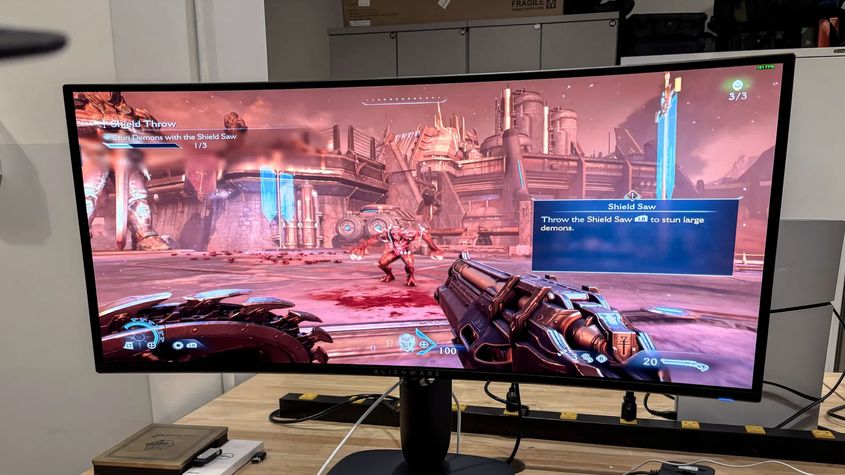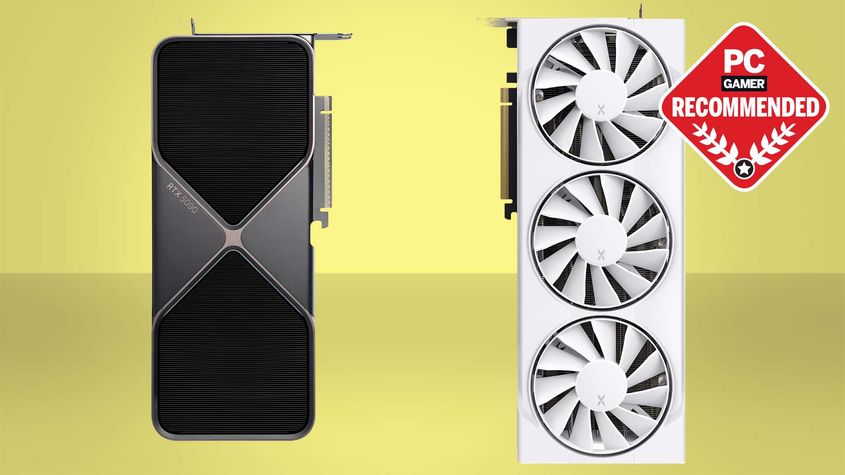
1. NVIDIA GeForce RTX 5090 – The Blackwell-Powered Titan
🔥 A Generational Leap in AI & Graphics
The RTX 5090 marks NVIDIA’s Blackwell architecture flagship, featuring:
- 21,760 CUDA cores
- 680 Tensor Cores (5th-gen)
- 170 RT Cores (4th-gen)
- 32 GB GDDR7 memory on a 512‑bit bus, delivering ~1.8 TB/s bandwidth
- Base ~2.0 GHz, Boost up to ~2.41 GHz
- TDP ~575 W, MSRP $1,999
This incredible spec sheet enables extreme real-time ray tracing and next-gen AI capabilities.
🚀 Performance & Benchmark Highlights
- 4K Gaming Supremacy
- Upgrades ~30% over the RTX 4090 in real 4K benchmarks unixsurplus.com+2Tom’s Guide+22.
- Some deep ray-tracing scenarios see up to 70% uplift thanks to DLSS 4’s Multi Frame Generation runpod.io+12unixsurplus.com+12The Verge+12.
- DLSS 4 and AI‑Driven Frame Generation
- Vision transformer-based DLSS 4 supports multiple generated frames per frame, with NVIDIA claiming possible 800% boosts in select titles TechSpot+15ويكيبيديا+15Tom’s Guide+15.
- AI enhancements improve both visual fidelity and latency (via Reflex 2), unlocking smoother experiences in ray-traced titles.
- Creative & AI Compute Power
- With 32 GB GDDR7 and 680 Tensor Cores, it handles AI workloads and video editing with class-leading speed.
- Procyon AI‑XL FP16 tests: ~40% faster than RTX 4090; PugetBench Resolve: ~12% faster ويكيبيديا+5Diario AS+5ويكيبيديا+5يوتيوب+15Vast AI+15NVIDIA+15.
- Thermals and Power
- Typical clocks range from 2.5 to 2.85 GHz under load; peak power can approach 575 W Windows Central+8Tom’s Hardware+8PC Gamer+8Tom’s Hardware.
- Suggested PSU: ≥1 kW.
⚙️ Strengths, Weaknesses & Ideal Users
Strengths:
- Absolute leader in ray tracing and AI-enhanced gaming.
- Exceptional for 4K ultra and high-refresh experiences.
- Great for creators, AI devs, and content professionals needing VRAM and Tensor horsepower.
Weaknesses:
- Massive power draw and thermal demands.
- Very expensive—closest competition is a full gaming PC.
- Some criticisms note diminishing returns past 4090 levels
Ideal For:
- Enthusiasts with high-refresh 4K setups (144 Hz+).
- Professionals in AI, VFX, video editing, scientific compute.
2. AMD Radeon RX 9060 XT – The Mainstream Powerhouse
🎯 RDNA 4 Efficiency Meets Budget-Friendly Value
Debuting June 5, 2025 as part of AMD’s RX 9000 family the RX 9060 XT targets value-conscious builders with:
- Navi 44 GPU (RDNA 4)
- 2,048 Stream Processors
- 32 Ray Accelerators / 64 AI Accelerators
- Clock Speeds: ~2.53 to 3.13 GHz on 16GB variant TechPowerUp++13HotHardware+13HotHardware
- Memory: 16 GB GDDR6 @ 20 Gbps, 128-bit bus, 320 GB/s bandwidth TechSpot+2+2HotHardware+2
- Cache/Interface: 32MB L3, PCIe 5.0 x16 supportTechSpot
MSRP: 8 GB @ $299, 16 GB @ $349 Tom’s Hardware+HotHardware+2.
⚖️ Performance & Value Analysis
- Rivalry with NVIDIA
- Outpaces 8GB graphics cards like RTX 5060/5060 Ti due to generous VRAM, excelling in 1440p and 1080p gaming alktech.co+15WIRED+15Windows Central+15StorageReview.com+6Tom’s Hardware+6alktech.co+6.
- Under $400, it matches or beats RTX 5060 at 1080p and leads at 1440p WIRED+1PC Gamer+1.
- VRAM Longevity
- 16 GB is now essential—even for 1080p—helping future-proof against texture memory creep Tom’s Hardware
- Ideal for AI workloads like Stable Diffusion XL, where smaller VRAM GPUs struggle Tom’s Hardware.
- Thermals and Power Use
- TDP ~150–180 W; Gigabyte OC variant clocks 3.13 GHz and runs cool/quiet with triple-fan design WIRED
- More efficient than older RDNA 3.
- Ray Tracing vs NVIDIA
- RT improves over previous AMD gen, but still trails NVIDIA’s dedicated RT cores The Verge+14HotHardware+14Windows Central+14ويكيبيديا+2Vast AI+2runpod.io+2.
- AMD’s FSR 4 offers solid upscaling in lieu of DLSS.
📊 Pros, Cons & Best Audience
Pros:
- Generous 16 GB VRAM is future-proof.
- Strong raster performance at mainstream settings.
- Reasonably priced—great cost-to-performance ratio.
Cons:
- Ray tracing underperforms vs NVIDIA’s DLSS-powered cards.
- Inconsistencies in benchmarks; some issues noted by reviewers PC GamerTom’s Hardware+1PC Gamer+1.
- Lacks DLSS-type AI features and frame generation.
Best For:
- Gamers on 1080p/1440p budgets who want longevity.
- Light creators or AI enthusiasts running inference tasks.
- Builders prioritizing value without compromising future needs.
3. Comparative Snapshot: RTX 5090 vs RX 9060 XT
| Feature | RTX 5090 | RX 9060 XT |
|---|---|---|
| Launch Date | Jan 30, 2025 | June 5, 2025 |
| Architecture | Blackwell (CUDA 21,760 cores) | RDNA 4 (Navi 44, 2,048 cores) |
| Memory | 32 GB GDDR7 @ ~1.8 TB/s | 16 GB GDDR6 @ 320 GB/s |
| AI/RT Cores | 680 Tensor, 170 RT (4th-gen) | 64 AI, 32 Ray Accelerators |
| TDP | 575 W | 150–180 W |
| Purpose | 4K ultra, AI computing, ray-tracing | 1080p/1440p value, future-proof VRAM |
| MSRP | $1,999 | $349 (16 GB) / $299 (8 GB) |
| Real‑World Use | Up to 30–70% faster than RTX 4090 in RT | Beats RTX 5060 at 1080p, leads at 1440p |
4. Which Card Should You Choose?
🔧 Powerful Gamers & Creators
- Go RTX 5090 if you have a high-budget 4K setup, want state-of-the-art AI and RT performance, or need serious VRAM for creative workloads.
💰 Prosumer & Budget-Conscious Users
- Pick RX 9060 XT 16 GB to get solid 1080p/1440p performance with modern VRAM, without overpaying.
5. Tech Trends & Looking Ahead
- VRAM Is King
The shift to 16 GB+ as mainstream is driven by increased texture sizes and rising AI needs - AI Upscaling Takes Off
DLSS 4 (vision transformer + frame generation) can yield up to 8× frame boosts while preserving latency and quality. AMD’s FSR is still competitive, but lacks the AI jump forward. - PCIe 5.0, GDDR7 & Power Demands
RTX 50 and RX 9000 series push new standards, but also escalate power needs—4k/60 Hz cards pulling 300–600 W are now commonplace.
6. Real-World Recommendations
RTX 5090 Owners & Buyers:
- Use for AI/deep learning, cinematic ray-tracing, or unmatched 4K gameplay.
- Ensure your PSU ≥1 kW and case supports 2x-slot + high airflow.
- Turn down frame‑gen on older 120 Hz TVs to prevent latency issues
RX 9060 XT Buyers:
- Opt for the 16 GB model—8 GB risks stuttering in modern titles.
- Great with AMD Ryzen 7000/8000 systems and 1440p monitors.
- Top up with FSR 4 when needed to maintain FPS.
7. Final Takeaway
- The RTX 5090 stands unchallenged in performance—ideal for those with 4K ambitions or powerful compute tasks.
- The RX 9060 XT dominates as a value flagship for mainstream gamers: enough VRAM, great price, and modern feature support.
- GPU choices in 2025 increasingly hinge on balancing performance, VRAM, and power constraints.
Would you like full benchmark charts, build compatibility advice (e.g., PSU, cooling, case sizes), or help picking between custom board partner models? I can also break down long-form buying guides or review mid-tier alternatives (like RX 9070, RTX 5070 Ti). Just say the word!
Relevant GPU News & Reviews


Best graphics card deals for every budget

Nvidia announces next-gen RTX 5090 and RTX 5080 GPUs








